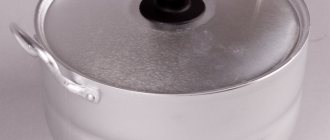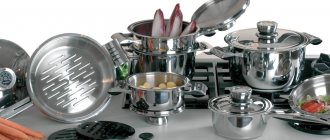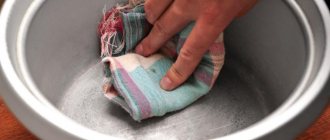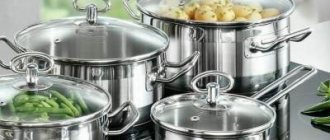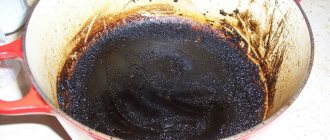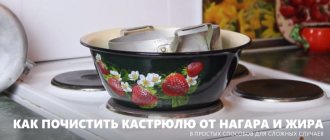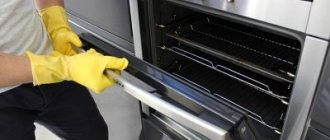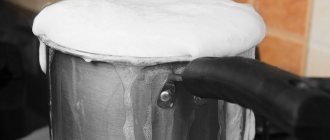In this case, you will need special tools or the use of home methods to tidy up the dishes without damaging their surface.
We will tell you more about how and how to clean a burnt pan (enamel, cast iron, aluminum, stainless steel) in the article.
How to remove smoke using folk remedies?
It is quite difficult to clean off burnt composition immediately . In order not to damage the pan itself, it is first advisable to fill the affected container with water and let it stand. This will soften the burnt layer, and it will be much easier to remove it.
Boiling
This method is the simplest, but often shows itself to be ineffective when food is significantly burned.
Procedure:
- fill the container with water so that the water covers all affected areas with some reserve;
- boil;
- cool;
- repeat the treatment 2-3 times.
If, after several boilings, carbon deposits still remain, you can remove the softened layer with a dish sponge.
Salt
For light stains, when the bottom of the pan is not very burnt, you can use regular kitchen salt. It is poured into a pan in a thick layer and left to act for 5-8 hours . After this, clean with a hard sponge. Wash the pan in the usual way with gel.
A concentrated saline solution will help remove burnt food from the pan.
How to use:
- Prepare a salt solution based on 5 tablespoons per liter of water. The liquid should cover all burnt areas, including on the walls of the dish.
- Place the pan on the fire.
- Boil for 1-1.5 hours.
- Cool.
- Treat with a sponge, removing softened carbon deposits.
Boiling with salt will give a more pronounced effect than dry application, but is not able to cope with advanced cases and old contamination.
Soda
Baking soda is an alkaline agent that can be used to remove burnt spots on the bottom of a pan.
Procedure:
- prepare a cleaning solution at the rate of 0.5 cups of powder per liter of water;
- put on fire;
- boil for at least 60 minutes;
- cool;
- clean with a kitchen sponge.
Soda-vinegar solution
For processing, it is necessary to prepare a concentrated solution of table vinegar, diluted in half with water. The solution is poured into a saucepan and brought to a boil. After removing from heat, add soda with a tablespoon. You need to add enough powder to form an extensive foam.
The pan is left to stand while the reaction takes place . After the foam settles, mechanical cleaning will proceed faster, as the carbon deposits will soften, and in some places even move away from the bottom and walls.
For old burns, the treatment must be repeated several times, preparing a fresh solution for each procedure.
Soda and peroxide
Adding peroxide will help enhance the effect of soda. For use, a composition is prepared at the rate of 3 parts baking soda to 2 parts water.
Usage:
- The resulting preparation is used to treat areas affected by burnt food.
- Leave to act for a quarter of an hour.
- Rubbing with a hard sponge.
Vinegar
Table vinegar can be used in several ways:
- in its pure form;
- in the form of an aqueous solution;
- with additional boiling.
Using vinegar requires good ventilation, this is especially important when using methods with heated solution.
Vinegar is used as follows:
- Pour the liquid directly from the bottle into the pan. It can be left alone or diluted with water in a ratio of 1:1 or 1:2.
- Heat, but do not bring to a boil.
- Leave for several hours.
- Clean the pan with a stiff sponge.
Heating is a factor that enhances the effects of acetic acid.
Activated carbon
The use of pharmaceutical activated carbon will help remove small stains, but not cope with old ones.
For processing, you need to remove the tablets from the package and grind them to a powder state. The number of tablets depends on the size of the burnt area.
Application:
- black powder obtained from tablets is poured onto the bottom so as to cover the affected areas;
- the pan is infused for several hours;
- water is added - enough is needed to cover all the stains;
- leave the pan for another hour and a half;
- cleaning with a sponge.
Mustard powder
Using mustard powder helps keep the bottom and walls of the pan clean. But this method will not overcome the burnt layer of porridge or jam.
Apply mustard to a damp sponge and rub the stained areas . The resulting cleaning slurry helps remove small, older stains.
You can enhance the effect by mixing mustard powder with soda and pre-rubbing the bottom of the pan with the mixture.
Serum
The lactic acid in the whey will help clean off burnt-on food. The product is poured into the pan in sufficient quantity to cover the burn marks. The minimum layer of liquid poured is from 20 mm.
Cover the pan with a lid and leave for several hours . During this time, the acid will soften the deposit, which will allow it to be removed without damaging the base material.
Apples, lemon
After burnt porridge, you can clean the pan using fresh apples. You need to choose fruits of sour varieties. A similar result can be obtained using lemons.
Procedure:
- Cut the apples into large pieces.
- Place in a saucepan.
- To fill with water.
- Boil for 30-60 minutes.
The more apples there are, and the more sour they are, the higher the effect due to the presence of fruit acid in the fruit.
Toothpaste
A non-standard use of toothpaste is for scrubbing burnt areas inside the pan. This method will give a good effect when the contamination is fresh. The paste is squeezed onto a sponge or directly into the pan and rubbed with the hard side.
Coca Cola
Coca-Cola can be used
to remove burnt marks .
The drink is poured into the affected pan and left to act for several hours. After this, rub with the hard side of the sponge.
The effect of the drink is due to the inclusion of carbon dioxide and phosphoric acid in its composition.
Cleaning from dark plaque
Over time, enamel cookware tends to become covered with a dark coating. This is especially helpful when cooking vegetables, for example, for vinaigrette. After a few months, you will notice that your pan has lost its original snow-white appearance. We share cleaning tips for removing dark plaque.
Method one
Dishes can be cleaned with baking soda. “Dry” or boil the pan with a solution of soda for 30 minutes, as recommended above. You can use two other, more effective methods using bleaching agents.
Method two
The “Whiteness” product, familiar to many, helps remove plaque without much effort. Pour water into the pan so that it covers the entire surface where there is plaque. Add “Belizna” to the water (2-3 tablespoons per 1 liter of water) and leave to stand for about a day. A significant part of the plaque will definitely go away. A necessary condition is that after the procedure with “Whiteness”, boil a pan of clean water twice to avoid chemical poisoning and remove odor.
Method three
2 tablespoons of dry bleach will do the trick, but only through the boiling process. Add bleach to a saucepan filled with water, bring to a boil and let simmer for about 3 minutes. After which it is enough to drain the water and make sure that all plaque has disappeared. Do not forget to thoroughly rinse the surface with plenty of water and be sure to boil it 1-2 times with clean water to completely remove the chemical.
If you want to change your enamel cookware to stainless steel cookware. Then we offer you an article on how to choose stainless steel cookware and not fall for the manufacturers’ tricks.
How to remove with special preparations?
In cases where home recipes are ineffective, you can try commercial cleaning products . These products dissolve even heavily burnt areas on the bottom and walls.
After cleaning with special preparations, the pan must be washed with dishwashing gel and rinsed well.
Grass Azelit Anti-grease Shiny cauldron
The cleaner comes in spray form . The drug is highly concentrated and will help cope with even old fat. Price for volume 0.6 l – from 125 rubles. Read reviews here.
Sano Forte Plus Concentrated fat removal gel
Gel concentrate allows you to cope with burnt fat and other contaminants. Forte Plus even copes with old burnt marks in pots and ovens. The action is fast and effective. Cost - about 500 rubles per package.
Meine Liebe Anti-grease
Anti-grease cleaning product is biodegradable and allows you to remove burnt fat from various types of surfaces, including frying pans and pots. Burnt food remains, even ingrained ones, can be removed quickly enough, without damaging the surface of the dish. The average price is from 200 rubles. Read reviews here, here and here.
Cleaning pots with craft glue
Ordinary glue, which can be found in every desk, can work real miracles with burnt dishes. You can use it as follows:
- prepare a cleaning composition by mixing 10 liters of water, a bottle of liquid glue, a glass of soda ash and a bar of ordinary laundry soap;
- bring this mass to a boil;
- cook the pots in the mixture for at least 15 minutes, but no more than 3 hours;
- then turn off the stove and leave the dishes in the container with glue, allowing them to cool;
- Now you can treat the surface of the pans with a washcloth or sponge, removing all unattractive soot from them.
Separately, it should be noted that it is not recommended to wash Teflon dishes in this way.
Features of cleaning various surfaces of kitchen utensils
The method for cleaning pans from burnt food must take into account the coating material of the cookware. This is an important point, since only certain methods of exposure are permissible for different surfaces.
Enameled
The enamel coating is unpretentious, but can be damaged by intense mechanical stress. Because of this, the use of hard sponges and metal scrapers is contraindicated .
Both acidic and alkaline compounds are suitable for cleaning burnt bottoms. If the whiteness of the enamel has been lost after processing or as a result of use, boiling it with a water-vinegar solution will help restore it.
In cases where there are chips and scratches on the inner surface of the pan that compromise the integrity of the coating, such utensils cannot be used for cooking.
Stainless steel
Stainless steel pans are durable, reliable and have a very long service life. You can deal with burnt areas using:
- vinegar,
- lemon,
- serums,
- Coca-Cola, etc.
Intensive cleaning with alkaline powders can cause scratches and loss of shine on the surface.
Aluminum
Aluminum pans are very demanding when choosing a cleaning method.
Acidic solutions are absolutely not suitable for processing , as they react with the material itself. The use of alkaline powders and solutions is also difficult - they can cause darkening of the surface.
It is advisable to avoid prolonged boiling with cleaning compounds, since this can cause the top layers of aluminum to become even more friable. This will increase the likelihood of food burning. Not all purchased products are designed to care for aluminum, so the information on the packaging should be read especially carefully before purchasing the product.
Teflon
The non-stick Teflon coating can also burn if the pan is used incorrectly. Since the Teflon layer is quite thin, it can be easily damaged .
Such utensils must be handled carefully, trying to avoid aggressive mechanical or chemical influences. To clean such surfaces, it is better to choose special preparations and a sponge designed for caring for Teflon coating.
Even with careful use according to all the rules, the protective coating becomes thinner over time. If food starts to burn regularly, the pan probably needs to be replaced.
Ceramics
Ceramic coating requires careful handling . Like Teflon, such a surface has its own shelf life, after which the dishes must be replaced with new ones.
To clean the burnt bottom of such dishes, you should not use alkaline agents or apply intense rubbing with washcloths. Temperature contrast, which leads to damage to the ceramic layer, is also prohibited.
Cleaning should be as gentle as possible . It is better to scrub burnt areas with a sponge soaked in vegetable oil. Another option for exposure is long-term pre-soaking.
Regular burning of food in a ceramic pan may indicate the need for replacement, since the coating has ceased to cope with its basic functions.
Cast iron
Cast iron cookware has an almost unlimited service life. Such a pan can only be damaged by mechanical force.
To clean such kitchen utensils, you can use almost any cleaning method without restrictions .
If the dishes are burnt and intensive processing is required, the surface of the bottom and walls may lose their natural protective layer. The porosity of the inner surface can also cause food to burn. If such a circumstance occurs, the frying pan will need to be heated with kitchen salt to restore the protective layer.
Suitable household chemicals
In the store you can find products for removing carbon deposits from pots and other kitchen utensils. The purchase of a product must be justified, so when choosing a product you need to consider three rules.
- Study the composition. It is better to give preference to a product without abrasive substances harmful to health and utensils.
- Pay attention to functionality. The product must be suitable for cleaning products made from different materials.
- Analyze reviews. Advice and recommendations from other housewives will help you make the right choice.
What to buy
The following products and brands have proven themselves well:
- "Shumanite";
- "Sanita";
- Amway;
- Cillit Bang.
To protect the surface of the product from scratches, it is advisable to give preference to products in the form of a gel or paste rather than powder.
How to use
You need to use cleaning agents to clean a burnt pan, strictly following the instructions. Typically, such products are used according to the following four-step algorithm.
- Pour the required amount of product into the pan.
- Fill with a certain amount of water.
- Boil and simmer over low heat for some time.
- Wash the product with detergent.
There is no need to run to the store: home methods will help solve the problem. Although such methods are called “grandmother’s”, their effectiveness has been proven by the experience of generations. If a stainless steel, aluminum or enamel pan is burnt, the following recommendations will tell you how to clean the product the old fashioned way.
The nuances of removing various food burnt inside from the bottom
Depending on what product is burnt in the pan, you can choose the most suitable processing option.
Sugar containing products
When sweet desserts (baked goods, jam, syrup) burn, it is advisable to use acidic cleaning compounds . If caramel or jam is burnt, you should not leave cleaning the pan for later. First you need to pour high-temperature water into it and let it stand for at least 3-5 hours.
If soaking does not help resolve the issue, the pan should be boiled with a cleaning agent, which is selected based on the material of the dishes.
If the burn from sweet food has hardened and the treatment has not been carried out in time, it will be difficult to clean the pan. You will have to act in several stages, combining soaking, boiling and scrubbing.
Milk
Burnt milk not only spoils the inside of pans, but also has an unpleasant odor. For cleaning, both acids (for example, lemon) and activated carbon or soda can be used.
If boiling milk is carried out frequently, it is recommended to purchase a special pan - a milk boiler . It has a special structure with two layers of walls.
This video will show you how to clean a pan from burnt milk:
Meat, potatoes
If a potato or meat dish is burnt, fill the pan with water as quickly as possible and let it sit. As a result, the deposits will begin to lag behind and can be removed. In order not to damage the surface, cleaning must be carried out in stages, in several passes.
Porridge
Cereals contain a large amount of fiber . This makes it easier to scrape burnt porridge from the bottom of the pan. You should start by soaking the affected bottom and walls. To do this, pour hot water into the container and leave the pan for at least half an hour. In advanced cases, you can try boiling.
Fat
It is not easy to remove burnt fat from a pan. Soaking in this case will not give a clear result. Mustard powder and soda will help deal with fresh soot. To quickly clean a long-burnt pan, it is more convenient to use special household chemicals.
Mild cases of burning
Method No. 1
Pour in vinegar and leave for 2-3 hours. It is better not to use vinegar essence because of its pungent odor. If there is no vinegar in the house, you can use citric acid or lemon juice dissolved in water, after first pouring boiling water over the lemon so that it releases maximum of its acidic properties.
Apple peel also contains acid, so it may be useful if you boil it in a pan where food has burnt.
Acid works well in cases of burning of a product containing sugar.
Method No. 2
Soda. A good cleaning product that has long been familiar to many housewives. In mild cases of burning, it is enough to wipe the darkened area with soda using a sponge. A few minutes and the result, as they say, is obvious.
What not to do and why?
When cleaning a burnt pan, you must remember the following prohibitions:
You should not use cleaning products that are not intended for use on dishes, as this can be harmful not only to the pan, but also to your health.- Do not clean with bare hands - you will need protective rubber gloves.
- Intensive mechanical cleaning methods should not be used as they may damage the surface.
- The type of coating material should not be ignored. You need to choose methods of influence only taking into account the material, so as not to completely ruin the pan.
Method 4. How to clean a pan from fat and carbon deposits using salt
The best way to clean a cast iron pan or cauldron, as well as enamel utensils, is with salt. It absorbs fat perfectly. In addition, being a soft abrasive, it also removes burnt marks well.
- Place a few handfuls of salt in the bottom (the more fat, the more salt you need to use) and scrub with a paper towel and a couple drops of dishwashing liquid.
- Simply rinse the pan under water (you don't need to use dishwashing liquid).
Adviсe:
- It is better to clean a burnt cast iron pan with coarse salt.
- Any pan, except a steel one, can be easily cleaned of scale and carbon deposits by boiling a strong brine solution in it (5-6 tablespoons of salt per 1 liter of water) for 30-40 minutes over low heat.
Recommendations
Expert advice will help you clean your dishes as efficiently as possible:
- If the cause of food burning is damage to the non-stick layer, then it is better to throw away such dishes, since using such a pan is not only unpleasant, but also harmful to health due to carcinogenic substances getting into the food.
- The use of the cleaning composition must be carried out according to the instructions, in compliance with safety precautions.
- When choosing the consistency of the cleaning product, it is necessary to take into account that powders can scratch the surface of the material, and sprays are used only if there is good ventilation.
Method 5. How to clean a burnt pan with vinegar
Vinegar is a powerful anti-burn and anti-limescale agent. However, it is not advisable to use it for cleaning enamel pans.
Instructions:
- Fill the bottom of the pan with vinegar (9%) and let sit for 1-3 hours. As the burnt material softens, carefully scrape it off with a spatula. You can reduce the smell of vinegar by packing the pan in a bag or wrapping it in cling film. And, of course, don't forget to open the window!
- Wash the dishes as usual.
Baking soda
Suitable for materials: stainless steel, cast iron, enamel.
Type of soot: porridge, sugar, pasta, milk, jam.
Instructions:
- Place the pot or pan in a larger container.
- Pour in so that it covers the product by a few centimeters.
- Add baking soda in a proportion of 0.5 kg per 5 liters of water.
- Boil for 2 hours.
- Cool and remove any remaining dirt.
Before boiling, remove plastic parts to avoid damage.
Video - how to clean a non-stick frying pan
Modern chemicals to combat carbon deposits
You can find many modern, effective cleaning products on the shelves of hardware stores. Most often, they are universal, suitable for cleaning any dirt from any dishes. But in order to avoid mistakes and not spoil Teflon or stainless steel, you need to read the instructions on the packaging and find out what kind of cookware the product is suitable for.
Among the general purpose chemicals:
- aggressive preparation Shumanit (for cleaning baking sheets, frying pans, pots and other utensils);
- cleaning products from the Amway product line;
- Sanita gels and powders;
- Sarma dishwashing and cleaning products.
Fairy, Sorti, AOS and other common brands of dishwashing gels are also suitable for removing not too strong deposits.
Milk serum
Suitable for materials: aluminum, enamel, ceramics, cast iron, stainless steel.
Type of burnt product: milk, jam, sugar, porridge.
Instructions:
- Fill the pan with whey until it covers the soot.
- Let stand for 24 hours.
- Drain off the whey and remove any remaining carbon deposits using traditional detergents.
It is not advisable to wash ceramic pots and pans using harsh abrasive products - they will scratch the surface, causing the food in such dishes to burn.
Choose a frying pan on which nothing burns
- Cast iron will prevent burning due to thick walls that distribute heat. Its only drawback is its heavy weight.
- Aluminum - must have a wall thickness of at least 5 mm, otherwise the food will burn. It is better to choose cast pans rather than stamped ones. The frying pan must have a non-stick coating.
- With Teflon coating they avoid burning, but require very careful care. When cooking, you should avoid metal spatulas, and also do not clean such a frying pan with abrasive products.
- Titanium frying pans have the positive qualities of cast iron. Their only drawback is their high price.
- The surface of ceramic frying pans is non-stick. But unscrupulous sellers can pass off a thin layer of enamel as ceramic; you need to be careful when choosing.
There should be no chips, cracks, or scratches - this will lead to food burning in these areas.
